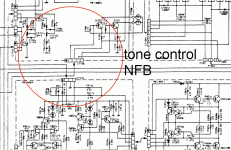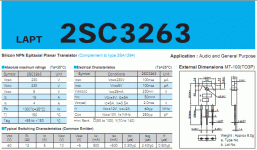Member
Joined 2009
Paid Member
Still Duo Beta was nothing more than a marketing phrase for keeping AC and DC feedback paths separate and in different proportion.Or is it more complex in your knowledge?
If you look at the 430 schema I posted , you see 3
So it does look a bit more involved than the leach split FB configuration (below 1).
So the tone controls are using the main amp as the gain stage (no other stage needed - as luxman says).
OS
Attachments
Last edited:
In my model they break the Fb resistor into two and they involve the tone controls on the first larger half. They linearise the tone circuits by nesting them in the loop, it is involved and unique, still its the main AC path. I am planning to recap the audio circuit lytics in mine, I have done the PSU and a NOS Lux pot a while ago. Its a good piece. It uses 2SC2577-2SA1102 power BJTs. I think I will get a quartet of the 20% heavier 2SC2581-2SA1106 Sanken to stash away for the future in case of an accident it will blow up and I will not be able to find any more.
In my model they break the Fb resistor into two and they involve the tone controls on the first larger half. They linearise the tone circuits by nesting them in the loop, it is involved and unique, still its the main AC path. I am planning to recap the audio circuit lytics in mine, I have done the PSU and a NOS Lux pot a while ago. Its a good piece. It uses 2SC2577-2SA1102 power BJTs. I think I will get a quartet of the 20% heavier 2SC2581-2SA1106 Sanken to stash away for the future in case of an accident it will blow up and I will not be able to find any more.
2SC2577-2SA1102 / 2SC2581-2SA1106 = old small weak power devices (8-10A 160-200Vce)
NJW0281/0302 (ON) , 2sc3263/a1294 (Sanken) are both 15A/250Vce with a much better beta match p-n . You would drive 4R MUCH better with a "quartet" of those ... cheap too.
These modern replacements even beat out the much larger vintage 2sa1095/c2565's in my nikko 230 (magic smoked devices).
I'm not JUST recapping my vintage amp, I'm "gutting it" (strip it down) to put in 2 pair of the 0281/0302 with RF grade teflon
I am building a preamp next , so I won't need tone controls on the amp.
OS
Still they must be 50-150 Hfe and Ft 20MhZ like the oldies it wares. Are those new ones much faster? That NFB loop is way too busy to hunt stabilizing.
Edit: Went seeing them. The ON is Ft 30MhZ, Sanken says 60MhZ. I like the ON beta matching and its rather near to what my Lux has now (20Mhz).
Edit: Went seeing them. The ON is Ft 30MhZ, Sanken says 60MhZ. I like the ON beta matching and its rather near to what my Lux has now (20Mhz).
Still they must be 50-150 Hfe and Ft 20MhZ like the oldies it wares. Are those new ones much faster? That NFB loop is way too busy to hunt stabilizing.
NJW0281/0302 = 75-150Hfe (mine 90-100) / 30mhz Ft
Sanken 2sc3263/sa1294 = also 50-150 Hfe (my pile tests at 100- 105) / 30mhz
Both the LUX'es and the Nikko's have C-B shunts (47p-100p) on the driver devices to "choke" any parasitics. Still, my choices would be perfect drop in replacements.
I have repaired a 100 amps with the 0281/0302's , they don't come back.
sankens are actually 35mhz Ft @ 12v ... http://www.sanken-ele.co.jp/en/prod/semicon/pdf/2sa1294e.pdf according to this... they have the slightly better sound (according to some) ??
OS
Last edited:
I'm glad the Japanese "Duo Beta" has now gotten some interest; after 30yrs. I'm only sorry that, as Not an electronics engineer, I can't shed any more light on it.
I will dig up from the papers I have around me in my "shed" to add substance to the 'Duo Beta' design battle against NFB and copy it here.
Perhaps you interested guys could latch onto my thread "Japanese to English" translation so that you can see where I'm coming from.
http://www.diyaudio.com/forums/solid-state/177658-japanese-english-translation.html
I'm attempting to get a worldwide response, through DIY-Audio, to
rebuild the powerful Luxman Z504 twin mono amp [with duo-beta design and make it available to everyone before it twinkles into extinction. --Such a waste--. [No tone controls....just pure amplification....]
I will dig up from the papers I have around me in my "shed" to add substance to the 'Duo Beta' design battle against NFB and copy it here.
Perhaps you interested guys could latch onto my thread "Japanese to English" translation so that you can see where I'm coming from.
http://www.diyaudio.com/forums/solid-state/177658-japanese-english-translation.html
I'm attempting to get a worldwide response, through DIY-Audio, to
rebuild the powerful Luxman Z504 twin mono amp [with duo-beta design and make it available to everyone before it twinkles into extinction. --Such a waste--. [No tone controls....just pure amplification....]
Low frequency response is very useful, if it maintained well and then your amp good maintained with it, it will give your amp great upgrades. One of mine I have been post it in complete. Duo beta is only necessary when needed, and will not working well if failed. Rebuilt it and redesign it isn't easy project if you going to replace some parts. You may get it different with the original. You need to learn how it really work.
- Status
- This old topic is closed. If you want to reopen this topic, contact a moderator using the "Report Post" button.
- Home
- Amplifiers
- Solid State
- NFB and load characteristics

